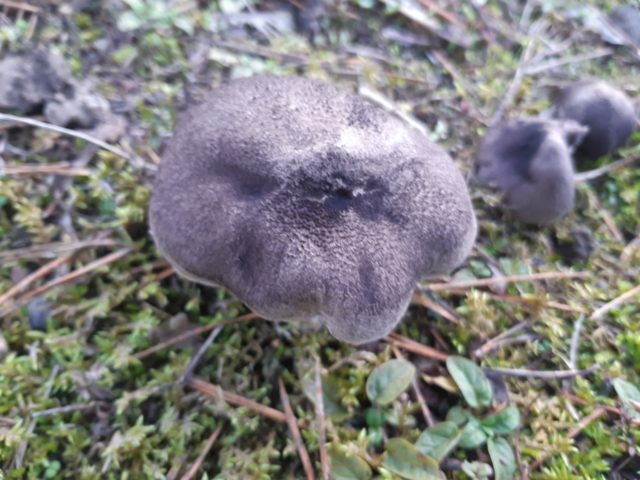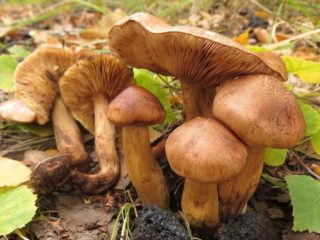Content
Ryadovka earthen (earthy-gray) or ground - a mushroom of the Tricholomov family. In biological reference books it is designated as Tricholoma bisporigerum, Agaricus terreus, Agaricus pullus; these specimens are popularly called baby mice. The species is classified as conditionally edible.
Where does the earthy row grow?
A common mushroom with a wide distribution area.In Russia, the earthen row grows in the subtropical zone and temperate climate. Forms numerous colonies, the main concentration of which is in Siberia, the Urals, and the Central regions. Not so widespread in the South. This is due to the method of development: the earthy row creates mycorrhiza only with coniferous species.
For abundant fruiting, calcareous, sandy or loamy soil is required. The mycelium is located on a coniferous, less often moss, litter. Mushrooms grow in long rows or in a dense semicircle. The earthen row forms families in forests, coniferous and mixed tracts with a predominance of pine, in urban park areas.
Fruiting occurs in autumn and is quite long-lasting. In temperate climates, the harvest is harvested from the end of August until the onset of frost (until October). On the Crimean Peninsula, where the main accumulation of earthy row is observed, the last fruiting bodies are found in December. In the Caucasus, fruiting lasts until the end of November.
What does the earthy row mushroom look like?
The earthen row is small in size. The fruit body is light or dark gray in color; occasionally there are specimens with a brown or reddish tint. The veil is present at the beginning of the growing season, then disappears completely or remains in the form of light openwork fragments along the edge of the cap.
The external description of the earthen row (pictured) is as follows:
- At the initial stage of development, the upper part of the fruiting body has the shape of a wide cone; as it matures, it becomes prostrate and flat; a conical tubercle is formed in the center of the cap; in rare cases, it is absent.
- The surface is silky, with small flakes. The plaque is weakly fixed; at the middle stage of maturation, the scales fall off or are washed away by precipitation.
- The protective film cracks in dry weather, and white pulp is clearly visible in places where it breaks.
- The diameter is about 8 cm, the edges of the cap can be straight or slightly wavy. At low humidity, rare longitudinal cracks of different sizes form along the edge.
- The color is not uniform: in the central part it is darker, the edges are light. Radial stripes are visible on the surface where the plates are attached.
- The spore-bearing layer is formed by sparsely spaced short and long plates with uneven edges. The color is white with a slight gray tint. The spores are white, cone-shaped. The long plates reach the base of the cap and do not cover the stem.
- The leg is long, cylindrical in shape, grows up to 10 cm. The surface has longitudinal stripes of fibers. The structure is hard, dry, brittle, flaking when cut, the inside is hollow. Young mushrooms are white, while mature ones have a grayish tint, identical to the lamellar layer. It is widened near the soil and narrows at the top. The surface near the cap is covered with a light felt coating. Remnants of the spathe are identified only in young rows in the form of a faint ring.
- At the beginning of the development of the fruiting body, the pulp is white, then light gray and thin.
Is it possible to eat earthy-gray row?
The species is classified as conditionally edible and occupies the fourth category in terms of nutritional value. Fruit bodies do not contain toxic compounds. The last classification niche for the row was given to its small size and thin flesh. Mushrooms are versatile in processing. You can get a good harvest in a relatively small area.
The species is mainly popular in Crimea; it is mass-harvested for all types of processing. The use of earthen grass in large quantities is not recommended. High concentrations of substances cause destruction of skeletal muscle cells. Experimental studies have proven that eating more than 40 kg in a short period can provoke kidney failure.
Taste qualities of mushroom
Among the Tricholomovaceae family, this species is the best in terms of nutritional value. The fruit bodies of the earthy row are distinguished by a pleasant, weak, sweetish taste. The smell is not repulsive, floury. Mushrooms are processed without prior boiling or soaking.
Benefits and harm to the body
The composition of the earthen row includes:
- a number of minerals that are especially useful for the functioning of the body: sodium, phosphorus, zinc, iron and calcium;
- betaine, vitamin complex;
- stearic, aspartic, glutamic acid, lysine, threonine, alanine;
- a number of phenols;
- ergosterol;
- the substances cletocin and femecin have the quality of natural antibiotics;
- polysaccharides.
The beneficial properties of earthen row are used for treatment:
- pathologies of the genitourinary system;
- normalization of pulse rate during arrhythmia;
- arterial hypertension;
- diseases of bone tissue (osteoporosis, rheumatism);
- dysfunction of the endocrine system. Mushrooms are useful for diabetes;
- reasons causing hormonal imbalance in women;
- obesity. Rows contain protein, so they are included in the diet; they completely replace meat dishes, but are less caloric.
Earthy rowing is contraindicated:
- for chronic stomach diseases that cause low acidity;
- during exacerbations of pathologies of the gallbladder and gastrointestinal tract;
- with pancreatitis, cholecystitis.
A large number of mushrooms can cause pain and intestinal upset.
How to distinguish earthy-gray rowing
The earthy-gray row is similar to several species, photos and descriptions of which are presented below.
The gray row is very similar in appearance to the earthen one.
An edible mushroom that differs from the earthy row:
- place of growth: found in mixed and deciduous forests;
- large size of the fruiting body;
- adult specimens have yellow spots on the spore-bearing layer;
- the pulp turns yellow when scrapped.
The fruiting period is late, the taste and smell are weak. The fruit body is versatile in processing.
Carved row or silver - conditionally edible species.
These mushrooms are lighter, the color is not gray, but light brown; adult specimens can be almost white. The pulp is yellowish, with a pleasant smell and unexpressed taste. After pickling, the fruit bodies turn yellow or light green. Fruiting is early (from the beginning of June), the species grows in mixed forests.
The row is sad belongs to the inedible group of mushrooms.
It grows and bears fruit in coniferous or mixed forests in symbiosis with pine, less often spruce. The main difference between the inedible species is the color and surface of the cap. The protective film is densely covered with small, tightly attached scales. The surface is felt-like. The edges are light, drooping, the central part is dark gray, there is no conical formation on the cap. Taste and smell are unexpressed.
Tiger row - poisonous species.
The cap is thick, fleshy, light gray.A distinctive feature is large flakes on the surface, arranged in stripes. The shape of the cap is round, with wavy, concave edges, on which cracks are visible. Grows in late summer in mixed or coniferous forests. May cause severe intoxication. The taste is sweetish, the smell is floury.
Collection rules
The family that this species belongs to is quite large. It consists mainly of mushrooms that are not edible, but look like edible ones. Therefore, the main rule when collecting earthen rows is to take only those fruiting bodies that are not in doubt. A few recommendations for mushroom pickers:
- Only young specimens are collected; overripe mushrooms release toxins during decomposition.
- Fruiting bodies are not taken from environmentally unfavorable areas, as they accumulate harmful substances.
- Cut off or break off the stem without damaging the mycelium.
- If several earthy rows are found, there is always a colony nearby.
- They search only under pine trees; the species does not grow under other tree species.
- The harvest comes at the end of summer; mushrooms appear after heavy rainfall.
How to prepare earthen row
The species is included in various dishes, which include mushrooms. The fruiting bodies are pre-treated to remove debris, soil fragments and mycelium on the stalk. If the mushroom is slightly damaged by insects, soak it in warm salt water for 15-20 minutes.
The following dishes can be prepared from the earthy-gray row mushroom:
- soup;
- vegetable stew;
- casserole with meat and potatoes;
- filling for pies or pies.
Mushrooms can be baked in the oven with vegetables or fried.
The earthen row is suitable for winter harvesting; after processing, it completely retains its chemical composition and is stored for a long time. Fruiting bodies are used for hot and cold pickling, they are pickled, dried, boiled and frozen.
Conclusion
The earthy row is a late lamellar mushroom. Found in the European part, Central and Southern regions. Grows in temperate and subtropical climates under coniferous trees in symbiosis with pine. Fruiting is abundant and long, the species is classified in the fourth category in terms of nutritional value.















